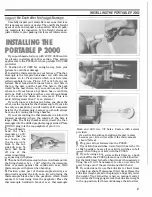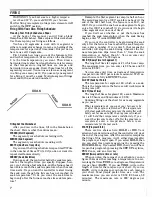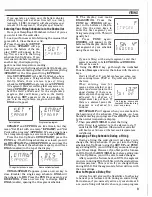
DISPLAY MESSAGES
Exercise
2:
Your controller temperature display is in
normal temperature mode. (Note: If
RUN
or
HOLD
appear in the display window alternating with a
temperature, skip this exercise until later.) Turn off the
on/off switch for the elements so that the furnace will
not begin firing.
Press the
DISP
key.
SP
will
appear in the bottom of the dis
play window. Write down the
number that appears. Use the
arrow keys to change the num-
ber. Then press the
SET
UP
key, which will take you out of
the
SP
display. (More later on
1
what
SP
means.) Now press the
DISP
key to get back
into normal temperature display.
Exercise 3:
Change the
SP
number back to what it
was before Exercise
2.
Experiment with this time
saving tip:
Time-saving tip:
When you press an arrow key to
change a time or temperature setting, the numbers will
change one at a time, but you can go into fast mode if
you want. Let's say you want to enter
500
into a program
from a zero setting. Hold down the "Up" arrow key.
You'll notice that the numbers increase slowly by one's.
Continue to hold down the "Up" arrow key, and press
the "Down" arrow key once. The numbers will go up in
tens instead of ones. If you press the "Down" arrow
again, the numbers will go up in hundreds.
The
RUNIIIOLD
key starts (runs) a programmed
firing. You can also press this key to pause (hold) a
programmed firing. When the furnace or kiln is firing,
the temperature will show in the top of the display,
alternating with
RUN.
If you touch the
RUNIIIOLD
key during firing, the
firing will pause (hold). The top of the display will then
alternate back and forth between
HOLD
and the
temperature. If you press
RUNIIIOLD
again, the firing
will continue.
Pressing
RUNIIIOLD
during a firing will NOT
turn the furnace off. It will only pause the {iring,
keeping the furnace at the temperature it was at
when you pressed
RUNIIIOLD.
The UDC
2000
is designed to fire many different
types
offurnaces. To fire each furnace correctly, it must
know the heating properties of that furnace. To find this
information, the controller puts the furnace through a
trial-run, called
Auto tune.
The
AUTO
TUNE
key on
the lower left starts this operation. We will show you
how to use this later.
At this point, the Set-Up Modes and their Function
Messages will probably read like Greek to you. Don't let
this concern you. You will probably never use most of
them; they're already set up at the factory for you. But
we will explain fully how to make the Set-Up adjust
ments you will need.
5
DISPLAY MESSAGES
While
a
When you're firing a program, the controller shows
the furnace temperature in the top display window. The
bottom display shows a series of operation messages
that tell you what the furnace is doing while firing.
To view these bottom display messages, press the
DISP
key. Each time you press it, one of four different
messages will display. This bottom display message will
stay on throughout the firing unless you press
DISP
again. Here is what these messages mean:
1 1.29 (SPPROG) or RP 1.20M (SPRAMP)
SPPROG:
(We'll explain
1
II
I
1.29
shortly what SPPROG and
SPRAMP mean.) The first num
ber is the firing segment the
controller is in. The second
number is the time left in that
segment. A ramp (temperature
rise or fall) is an odd number,
SPPROG
ramp
1,
and a soak (holding tempera-
1
hour
29 minutes left.
ture steady) is an even number. In this example, one
hour and
29
minutes remain in segment
1,
a ramp.
If you use rate as a ramp unit, the bottom display
during firing will not show time left in a ramp
(1
1.29).
Instead it will show
degrees per minute
(1
10-
segment 1, 10 degrees per
minute).
SPRAMP:
RP
means you are
in the single-ramp program.
The number is total time in
minutes of the program.
OT 100.0
1
�7 P
120
r1
SPRAMP program: total
time in minutes
The controller cycles the heating elements on and off
to reach a temperature. This
reading tells you in percentage
how long the elements stay on
during each on/off cycle. In this
case, the elements stay on
100%
of the time.
OT
means output.
SP 502
1
nT
u ;
IInnn
.uu.u
SP
means set point. In this case, the set point
temperature is
5020•
Set point is
the temperature the controller
is trying to maintain inside the
B F
furnace. The actual furnace
1
temperature is in the top of the
s: p 5 02
display in large numbers.
DE·420
This is the difference in degrees between the
temperature of the furnace and the set point, or the
tem perature it is working
towards.
DE
means deviation.
In this case, the furnace is
4200
off from the temperature it is
working towards.
1
n E
..
li2 0












